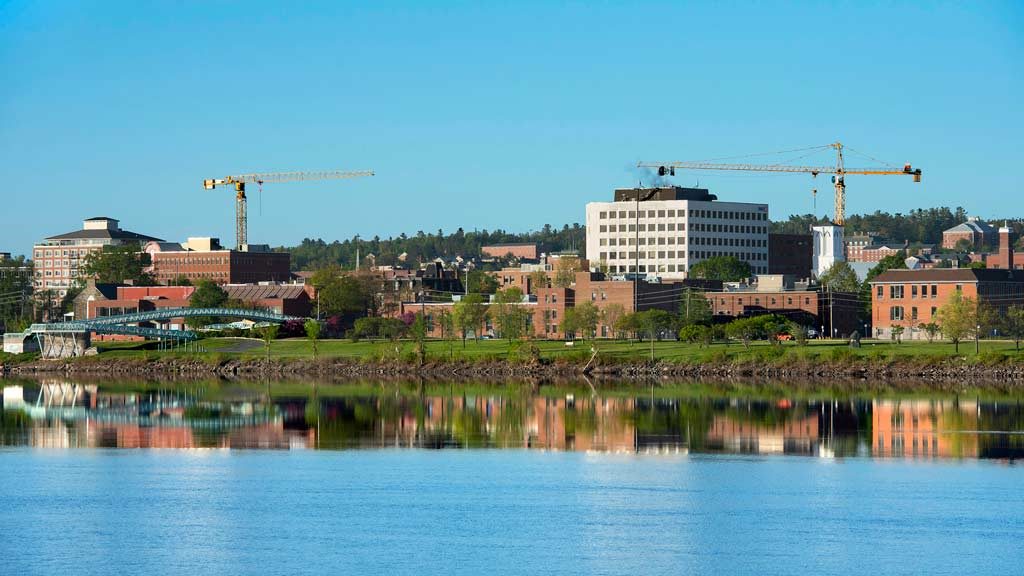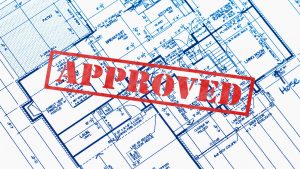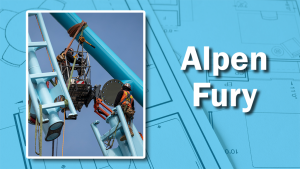Construction in Fredericton, N.B. is brisk, with almost 300,000 square feet of office and tech space being built and several downtown office proposals are in the construction queue. Residential midrise projects are also picking up steam in the core.
One building that will be completed this summer downtown is a 90,000 square foot office tower by Ross Ventures. It will be Fredericton’s first Class A office building constructed in more than a decade.
A construction management project by Bird Construction, it is a concrete cast-in-place building with a glass curtainwall.
“There’s not another building in Fredericton like it,” Jeff Yerxa, CEO, Ross Ventures, says, noting while glass buildings are common in many cities, not so in Fredericton.
Project architect Moncton-based Architects 4 designed a curtainwall with floor-to-ceiling windows — “a real step forward in design” for the city of 65,000 residents, Yerxa says. While the curtainwall contractor is from Quebec, the building otherwise is being constructed by New Brunswick contractors using local labour.
The construction has seen a few hitches, he says, pointing out that the biggest hurdle was the weather last winter. Snow storms and cold disrupted concrete pours and other construction work. “Overall, it has been a good project, on budget and schedule.”
Yerxa says the building will meet BOMA certified international guidelines for design and environmental standards, which include a scorecard for energy efficiency. It will be “very efficient,” using a closed water loop ceiling-mounted heat pump system.
Another office project under construction nearby in downtown is a 60,000 square foot building by Waverley Developments. Meanwhile, in the suburbs 140,000 square feet of tech space is being developed at Knowledge Park, Atlantic Canada’s largest research and technology park.
John Landry, executive director, Construction Association of New Brunswick, says the increase in office development is good for his members.
One of those members — Springhill Construction — is involved in the retrofit of the historic Centennial Building which housed offices of premiers and civil servants for years. Owners of the downtown landmark are looking for tenants, possibly for commercial offices and or a hotel.
Ken Forrest, the city’s planning and development department director says a perception in much of Canada that Atlantic Canada’s economy is slow is misleading.
“There are some success stories here” and Fredericton is one of them, he said.
The residential sector is outpacing all building sectors, Forrest says, noting that the 400 residential units — both home sales and rentals — built annually in Fredericton don’t meet the growing demand.
“We probably have to do (build) about double that for a couple of years just to get caught up,” Forrest says, adding that much of the housing demand is for medium to high-density residential. Currently, the city’s residential vacancy rate is 1.4 percent.
A growing population — Fredericton adds about 2,000 residents annually (many from overseas) — and increasing employment in the tech sector, small business and other areas are fuel to the building economy, Forrest says. “It is not so much a boom as it is the new normal…that we think will be sustained.”
While residential is a small portfolio for Ross Ventures, “it is definitely an area we are actively growing,” says Yerxa, noting that part of the inner city’s residential growth is spurred on by migration from rural communities to cities in New Brunswick. “Older people are coming to be closer to services and younger people are coming for jobs.”
Ironically, most of the development in the province’s capital city is not from government sources but from the private sector, Forrest says.
Major employment is in high tech, engineering, environmental sciences and other “white collar tech” sectors. “We feel like we are in a good place.”
The city’s planner says Fredericton will become a Census Metropolitan Area in 2021. Its trading area covering western New Brunswick is 300,000 to 350,000 residents.











Recent Comments
comments for this post are closed